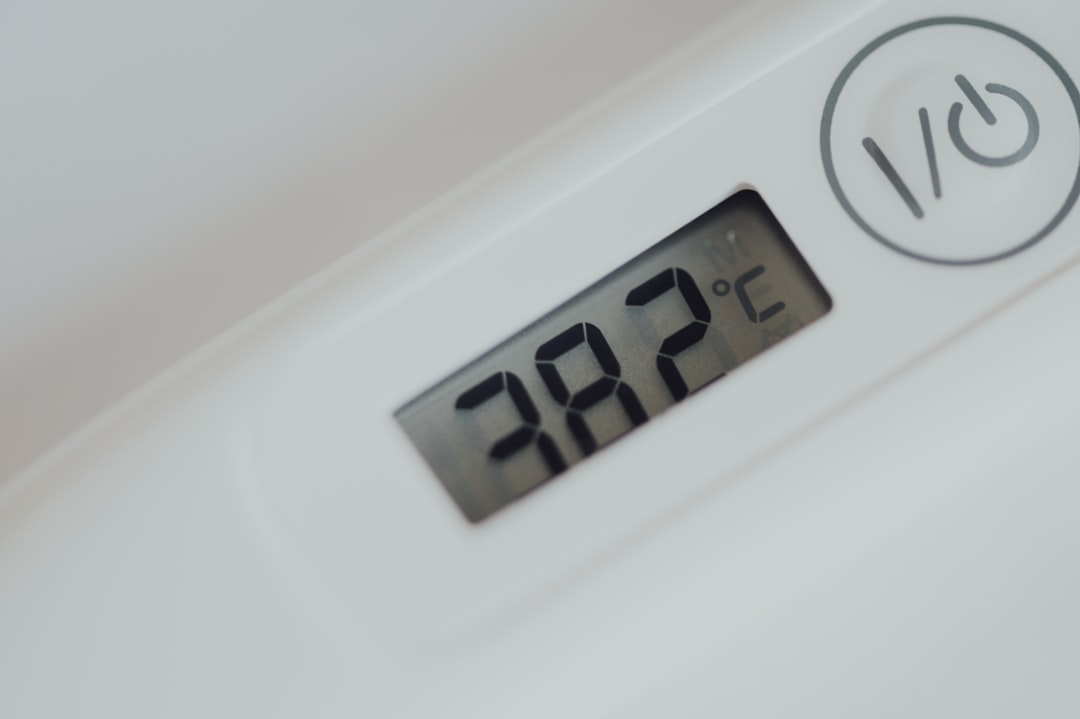Beat the Heat: Solving the AC-Thermostat Mismatch
-

When Your AC Can’t Keep Up: Understanding Temperature Control Issues
Why is my ac not keeping up with thermostat is one of the most common HVAC questions homeowners face, especially during peak summer months. Here’s what you need to know:
Most Common Causes:
- Dirty air filters – blocks airflow and reduces cooling capacity
- Low refrigerant levels – prevents proper heat exchange
- Thermostat placement issues – direct sunlight or drafts cause false readings
- Leaky ductwork – cooled air escapes before reaching living spaces
- Extreme outdoor temperatures – AC systems are sized for 98% of typical weather conditions
Quick Check: If your thermostat shows 78°F but you set it to 74°F, and this gap persists for hours, you likely have a mechanical issue rather than just a hot day.
You’ve set your thermostat to a comfortable 72°F, but your home stubbornly stays at 76°F or higher. The AC runs constantly, your energy bills spike, and you’re left wondering if your system is broken. This frustrating scenario affects millions of homeowners, but most causes are fixable.
Central air conditioning systems are typically sized to handle 98% of your area’s high temperatures efficiently. During extreme heat waves – that remaining 2% of days – even properly functioning systems may struggle to reach your exact thermostat setting.
I’m Courtney Zalesak, and during my decade at Malek Service Company, I’ve helped countless homeowners solve this puzzle through strategic system improvements and targeted repairs.

Why Is My AC Not Keeping Up with Thermostat?
When you’re asking yourself “why is my ac not keeping up with thermostat,” you’re dealing with what HVAC professionals call a temperature gap – that frustrating difference between what you’ve set and what you’re actually getting.
Your air conditioner wasn’t designed to work miracles. HVAC contractors use detailed load calculations that factor in your home’s square footage, insulation quality, window placement, and local climate patterns. The industry standard aims for systems that can handle about 98% of your area’s typical high temperatures efficiently.
What does that 98% rule mean? During the hottest 2% of days each year – those brutal heat waves – even a perfectly functioning AC might struggle to hit your exact thermostat setting. That’s normal engineering, not system failure.
But here’s the key difference: a persistent temperature gap that happens regardless of outdoor conditions signals real trouble. Your system should consistently get within 1-2°F of your target temperature during typical weather.
“why is my ac not keeping up with thermostat” – Snapshot Causes
The most common reasons behind why is my ac not keeping up with thermostat usually fall into five main categories, and several are surprisingly simple fixes.
Dirty air filters top the list as the number one culprit. When filters get clogged with dust, pet hair, and debris, your system can’t move enough air to cool effectively.
Low refrigerant levels create another major bottleneck. When leaks develop, there isn’t enough refrigerant to absorb indoor heat and dump it outside. Your system runs constantly but never quite catches up.
Thermostat misreading happens more often than you’d expect. If your thermostat sits in direct sunlight, near a heat-producing appliance, or in a drafty hallway, it’s getting false temperature readings.
Duct leaks silently sabotage your comfort by letting cooled air escape into attics, crawl spaces, or wall cavities before it reaches your living areas. Some homes lose up to one-third of their cooling capacity this way.
Extreme outdoor heat can overwhelm even properly sized systems. When temperatures soar well above your area’s typical summer highs, your AC may fall short by a few degrees – and that’s actually normal behavior.
How Big Should the Gap Be?
Understanding what’s normal versus problematic helps you know when to worry and when to just wait for cooler weather.
During moderate weather with outdoor temperatures under 85°F, expect your AC to get within 0-2°F of your thermostat setting. When hot weather hits the 85-95°F range, a 2-4°F gap is still reasonable. During extreme heat over 95°F, even well-functioning systems might show a 4-6°F difference.
The 20°F rule provides another helpful benchmark: most residential AC systems can realistically cool about 20°F below outdoor temperature. So on a scorching 95°F day, getting your home down to 75°F represents solid performance.
Red flags that indicate real problems include a consistent 5°F or larger gap regardless of weather, temperature differences that worsen over time, or systems that never reach your setpoint even during mild overnight hours.
Outdoor Temperature Normal Gap Problem Gap Under 85°F 0-2°F 5°F+ 85-95°F 2-4°F 6°F+ Over 95°F 4-6°F 8°F+ Mechanical & Airflow Culprits

Most cooling problems start with airflow. Your system needs a clear path to move heat from inside your home to the outdoors. When that path is blocked, even the best equipment under-performs.
A quick refresher: the evaporator coil inside your air handler absorbs indoor heat, while the condenser coil outside releases it. The blower motor pushes air across the coils and through your ducts. Any restriction in this loop—dirt, damage, or weak components—creates the temperature gap you feel.
For a deeper dive, see Why Does My AC Have Low Airflow? and the ENERGY STAR guide on HVAC efficiency.
Filters, Vents & Ductwork
- Check your filter monthly in summer and replace at least every three months—more often with pets or heavy pollen.
- Keep every supply vent open; closing vents raises static pressure and can damage duct seams.
- Insulate and seal attic ducts. Uninsulated metal baking in a 130 °F attic reheats air before it ever reaches you.
Refrigerant & Frozen Coils
A sealed AC never “uses up” refrigerant, so needing a recharge means there’s a leak. Low charge or poor airflow lets moisture freeze on the coil, turning it into an ice blanket that blocks heat transfer. If you see frost, shut the system off, run the fan to thaw, and call a pro.
Undersized or Oversized Equipment
Correct capacity comes from a Manual J load calculation, not square-foot rules of thumb. Undersized units run nonstop; oversized ones short-cycle and leave humidity behind. Either way, you’ll notice the thermostat gap. If your home was renovated or your system was replaced without a new load calc, size could be the root cause.
Thermostat & Control Issues

Your thermostat is essentially your AC system’s brain, so when it malfunctions, your entire cooling system suffers. Many homeowners assume their AC unit is broken when the real culprit is a faulty or poorly placed thermostat.
Think of it this way: if your thermostat thinks your home is 72°F when it’s actually 78°F, your AC will shut off prematurely, leaving you hot and frustrated. This miscommunication between the thermostat and your comfort level is surprisingly common.
Poor thermostat placement is one of the biggest issues we see. Calibration drift over time, sensor malfunctions, loose wiring connections, dead batteries, and software glitches in smart thermostats can all cause your system to behave erratically.
The good news? Many thermostat problems have simple fixes that don’t require professional service. However, some issues do need expert attention to prevent further damage to your cooling system.
For more detailed troubleshooting guidance, check out our More info about A/C Troubleshooting resource.
“why is my ac not keeping up with thermostat” – When the Brain Lies
Your thermostat can only control what it can accurately measure. When it’s getting false temperature readings, it makes the wrong decisions about when to run your AC.
Direct sunlight is the worst enemy of accurate thermostat readings. A thermostat mounted on a wall that gets afternoon sun might read 80°F while the rest of your home sits at a comfortable 72°F. Your AC shuts off, thinking the job is done, while you’re left wondering why is my ac not keeping up with thermostat settings.
Drafts from windows, doors, or nearby air vents create similar problems. Cold drafts can trick the thermostat into thinking your home is cooler than it actually is, while warm drafts from kitchens or sunny areas cause the opposite effect.
Old mercury switch thermostats are particularly finicky about placement. These mechanical units rely on a tiny bubble of mercury that rolls back and forth to make electrical contact. If the thermostat isn’t perfectly level, that mercury bubble won’t trigger the switch at the right temperature.
Even modern digital thermostats develop sensor drift over time. According to Scientific research on thermostat adjustment, proper calibration and strategic placement are crucial for reliable temperature control.
Quick Thermostat Fixes
Before calling for professional help, try these simple solutions that often restore proper thermostat operation.
Clean the internals by removing the thermostat cover and gently brushing away dust and debris from the sensors. Pet hair and household dust can interfere with temperature readings.
Replace the batteries even if your display looks normal. Weak batteries cause erratic behavior long before the low battery warning appears. Make this an annual maintenance task.
Check the level mounting if you have an older mechanical thermostat. Use a small carpenter’s level to ensure it’s perfectly horizontal. Even a slight tilt can throw off the mercury switch.
Apply a calibration offset if your thermostat consistently reads differently than an accurate thermometer placed nearby. Most digital thermostats allow you to adjust the displayed temperature by a few degrees.
Perform a firmware reset on smart thermostats that are acting glitchy. Factory resets clear software bugs and restore default settings.
Home & Weather Factors You Can Control
Your AC fights two kinds of heat: what leaks in from outside and what you generate indoors. Minimize those loads and the same equipment instantly performs better.
- Solar gain: Close blinds on east windows in the morning and west windows after lunch. Blackout curtains or reflective film can cut window heat by 30 % or more.
- Insulation: Attic insulation and radiant barriers keep attic temps—hence your duct temps—lower.
- Internal loads: Cook, dry clothes, or run the dishwasher after dark. Swap incandescent bulbs for LEDs that give off far less heat.
- Fans & humidity: Ceiling fans make you feel 3–4 °F cooler, letting you raise the thermostat. Keep indoor humidity below 55 % so air feels crisp, not clammy.
Heat-Wave Survival Tactics
- Pre-cool early. Drop the set-point 2 °F at sunrise, then return to normal once the sun is high.
- Use portable and ceiling fans in occupied rooms; turn them off when you leave.
- Grill outside instead of using the oven on 100 °F days.
- Seal gaps around doors and attic hatches—cheap weather-strip prevents a surprising amount of heat and humidity from sneaking in.
Continuous runtime during a 100 °F spell doesn’t always mean failure; it can simply mean the system is working at its engineered limit.
DIY Fixes vs. Professional Help
A few minutes with basic tools can solve many comfort gaps:
- Replace the filter and vacuum supply/return grilles.
- Verify the thermostat batteries and settings.
- Rinse debris from the outdoor coil with a gentle garden-hose spray (power washers destroy fins).
- Check the circuit breaker that serves your air handler and condenser.
Stop there if you see ice on the indoor coil, suspect a refrigerant leak, or notice burning smells. Refrigerant work, major electrical repairs, and duct modifications belong to licensed technicians. They have the gauges, vacuum pumps, and training to protect your equipment—and its warranty.
Signs you need a pro from Malek Service:
- Temperature gap persists after the quick fixes.
- System short-cycles or runs nonstop without cooling.
- Multiple rooms are warm, hinting at duct or sizing problems.
- Energy bills jump for no clear reason.
Our AC Maintenance College Station team serves homes across Brazos Valley and the Houston area, resolving issues safely and efficiently.
Frequently Asked Questions about AC-Thermostat Mismatch
How often should I replace air filters to prevent mismatch?
The simple answer? Check monthly, replace every three months – but your home might have different needs.
I always tell homeowners that pet owners need to replace filters monthly because pet dander and hair clog filters much faster than normal household dust. If you’ve got a furry family member, don’t wait the full three months.
During high pollen seasons in spring and fall, you’ll want to replace filters every 6-8 weeks. Pollen creates a fine layer that blocks airflow surprisingly quickly. I’ve seen perfectly good AC systems struggle to reach thermostat settings simply because spring pollen turned their filter into a wall.
Homes in dusty areas or near construction should check filters every two weeks. Family members with allergies often benefit from monthly filter changes too – cleaner air and better AC performance go hand in hand.
A clogged filter is the #1 reason why is my ac not keeping up with thermostat calls come into our office. It’s the easiest fix that makes the biggest difference.
Can extreme outdoor temps make any correctly sized AC fall behind?
Absolutely, and this catches many homeowners off guard. Your AC system is intentionally designed to handle 98% of typical high temperatures in your area – not every single day of the year.
Here’s why this matters: if your area typically sees summer highs around 93°F, your system is sized perfectly for that condition. But when a heat wave pushes temperatures to 100°F or higher, even a brand-new, perfectly maintained system may fall 2-4°F short of your thermostat setting.
This isn’t a malfunction – it’s smart engineering. Sizing an AC system for the absolute peak temperatures would mean installing a much larger unit that would be oversized for normal weather. Oversized systems create their own problems: they short-cycle, waste energy, and don’t remove humidity properly.
During extreme heat, your AC running continuously while staying 3°F above your setpoint is actually normal behavior. The system is working as hard as it can within its design limits.
Will a smart thermostat fix the problem automatically?
Smart thermostats are impressive pieces of technology, but they’re not magic wands that fix underlying mechanical problems.
Learning algorithms help smart thermostats understand your schedule and adjust accordingly. Remote sensors can average temperatures from multiple rooms instead of relying on one location. Weather integration lets the thermostat pre-cool your home before hot weather hits, and usage reports can identify patterns that waste energy.
These features can definitely help optimize your system’s performance and may improve comfort. However, if why is my ac not keeping up with thermostat is caused by dirty coils, refrigerant leaks, or an undersized system, no amount of smart technology will solve those mechanical issues.
Think of it this way: a smart thermostat is like having a really good driver for your car. They can get better performance out of the vehicle, but they can’t fix a flat tire or empty gas tank.
If your current thermostat reads temperatures accurately and is placed correctly, upgrading to a smart model will provide convenience and minor efficiency improvements. But for dramatic temperature control improvements, you’ll need to address any underlying system problems first.
Conclusion
Most “AC won’t keep up” calls boil down to three things: a clogged filter, a thermostat mis-reading the room, or airflow restrictions inside the unit or ducts. Check those first—you might fix the problem in ten minutes and a few dollars.
If the simple steps don’t close the temperature gap, or if you notice ice, leaks, or electrical odors, it’s time for professional diagnostics. Malek’s licensed technicians serve College Station, Houston, and surrounding communities with the tools and training to restore peak performance fast.
Ready to enjoy consistent comfort again? Schedule service today at Malek Service or call 979-446-0296.
July 1, 2025






